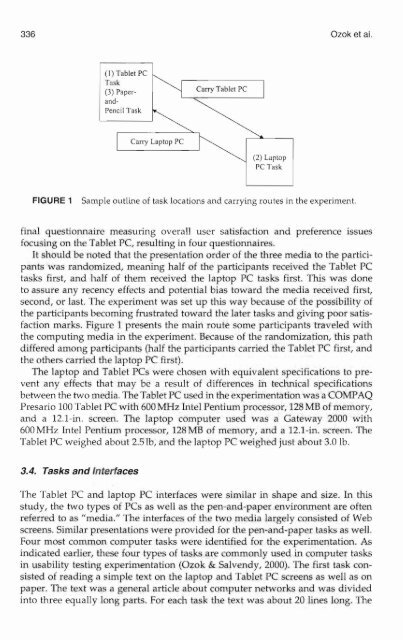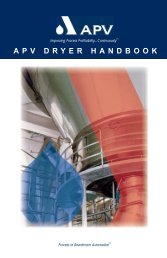A Comparative Study Between Tablet and Laptop PCs: User ... - Umbc
A Comparative Study Between Tablet and Laptop PCs: User ... - Umbc
A Comparative Study Between Tablet and Laptop PCs: User ... - Umbc
You also want an ePaper? Increase the reach of your titles
YUMPU automatically turns print PDFs into web optimized ePapers that Google loves.
336 Ozok et al.<br />
(1) <strong>Tablet</strong> PC<br />
Task<br />
(3) Paper<strong>and</strong>-<br />
Pencil Task<br />
Carry <strong>Laptop</strong> PC<br />
Carry <strong>Tablet</strong> PC<br />
(2) <strong>Laptop</strong><br />
PC Task<br />
FIGURE 1 Sample outline of task locations <strong>and</strong> carrying routes in the experiment.<br />
final questionnaire measuring overall user satisfaction <strong>and</strong> preference issues<br />
focusing on the <strong>Tablet</strong> PC, resulting in four questioill1aires.<br />
It should be noted that the presentation order of the three media to the participants<br />
was r<strong>and</strong>omized, meaning half of the participants received the <strong>Tablet</strong> PC<br />
tasks first, <strong>and</strong> half of them received the laptop PC tasks first. This was done<br />
to assure any recency effects <strong>and</strong> potential bias toward the media received first,<br />
second, or last. The experiment was set up this way because of the possibility of<br />
the participants becoming frustrated toward the later tasks <strong>and</strong> giving poor satisfaction<br />
marks. Figure 1 presents the main route some participants traveled with<br />
the computing media in the experiment. Because of the r<strong>and</strong>omization, this path<br />
differed among participants (half the participants carried the <strong>Tablet</strong> PC first, <strong>and</strong><br />
the others carried the laptop PC first).<br />
The laptop <strong>and</strong> <strong>Tablet</strong> <strong>PCs</strong> were chosen with equivalent specifications to prevent<br />
any effects that may be a result of differences in technical specifications<br />
between the two media. The <strong>Tablet</strong> PC used in the experimentation was a COMPAQ<br />
Presario 100 <strong>Tablet</strong> PC with 600 MHz Intel Pentium processor, 128 MB of memory,<br />
<strong>and</strong> a 12.1-in. screen. The laptop computer used was a Gateway 2000 with<br />
600MHz Intel Pentium processor, 128MB of memory, <strong>and</strong> a 12.1-in. screen. The<br />
<strong>Tablet</strong> PC weighed about 2.5Ib, <strong>and</strong> the laptop PC weighed just about 3.0 lb.<br />
3.4. Tasks <strong>and</strong> Interfaces<br />
The <strong>Tablet</strong> PC <strong>and</strong> laptop PC interfaces were similar in shape <strong>and</strong> size. In this<br />
study, the two types of <strong>PCs</strong> as well as the pen-<strong>and</strong>-paper environment are often<br />
referred to as "media." The interfaces of the two media largely consisted of Web<br />
screens. Similar presentations were provided for the pen-<strong>and</strong>-paper tasks as well.<br />
Four most common computer tasks were identified for the experimentation. As<br />
indicated earlier, these four types of tasks are commonly used in computer tasks<br />
in usability testing experimentation (Ozok & Salvendy, 2000). The first task consisted<br />
of reading a simple text on the laptop <strong>and</strong> <strong>Tablet</strong> PC screens as well as on<br />
paper. The text was a general article about computer networks <strong>and</strong> was divided<br />
into three equally long parts. For each task the text was about 20 lines long. The











